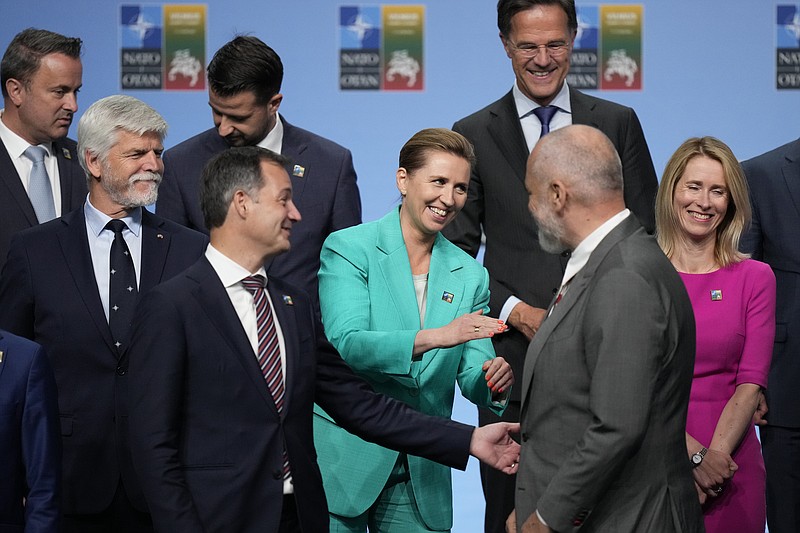VILNIUS, Lithuania -- U.S. President Joe Biden and his NATO counterparts on Tuesday endorsed the biggest shakeup since the Cold War of the way the military alliance would respond to any attack on its territory by Russia.
Inspired in part by Moscow's invasion of Ukraine, the highly secretive defense plans lay out which of the 31 member countries would be called on to respond to an attack anywhere from the Arctic and Baltic Sea regions through the northern Atlantic and south to the Mediterranean and Black seas.
"Peace in the Euro-Atlantic area has been shattered," the leaders said in a statement, laying out the twin threats posed by Russia and terrorism. "Together, this family of plans will significantly improve our ability and readiness to deter and defend against any threats, including on short or no notice, and ensure timely reinforcement of all Allies."
The leaders, meeting in Vilnius, Lithuania, "committed to fully resource and regularly exercise these plans to be prepared for high-intensity and multi-domain collective defense."
Under the new plans, NATO commanders will know more clearly what troops and equipment they would have at their disposal and how long it would take to have them in place, officials said.
The defense blueprint was revamped after Russia's war on Ukraine challenged NATO's traditional security calculus.
NATO, as an organization, does not provide weapons or ammunition to Ukraine. It has sought to avoid being dragged into a wider war with nuclear-armed Russia. At the same time, it is massively reinforcing the security of member countries near Russia, Ukraine and Belarus.
Around 40,000 troops are on standby from Estonia along NATO's eastern flank with Russia and down to Romania on the Black Sea. About 100 aircraft take to the skies in that territory each day, and a total of 27 warships are operating in the Baltic and Mediterranean seas. Those numbers are set to rise.
Under its new plans, NATO aims to have up to 300,000 troops ready to move to its eastern flank within 30 days. The plans divide its territory into three zones -- the high north and Atlantic area, a zone north of the Alps, and another in southern Europe.
The planning was based on the strength of the Russian army before President Vladimir Putin launched the war on Ukraine almost 17 months ago. The war has depleted Russia's army, but not its navy or air force, top NATO brass say.
NATO's 31 member countries took part in a "force generation conference" in late June in an effort to understand how many troops and how much equipment the alliance might have at its disposal to respond to any Russian attack, in both the short and longer terms.
Senior officers were upbeat about the results, although they declined to provide details for security reasons. Experts and some NATO diplomats, however, have expressed doubt about the willingness of member countries to put a total of 300,000 troops on standby.
One part of the process that has not been streamlined is the need for all 31 allies to approve launching the new plans in case of attack, and at certain points once they're put into action. Such political decisions, which require consensus, can be time-consuming.
"Political decision makers still retain political control," a senior U.S. official told reporters in the days leading up to the summit.
NATO's Supreme Allied Commander, U.S. General Christopher Cavoli, "still has to come back to the NAC to ask for permission," the official said, referring to the North Atlantic Council, NATO's chief decision-making body which meets at the level of ambassadors, ministers or national leaders.
"But he might have more authority, once that permission is given, to stage and move forces around in theater," the official said, on condition of anonymity because the planning documents were still under discussion.
UKRAINE'S NATO HOPES
NATO leaders said Tuesday that they would allow Ukraine to join the alliance "when allies agree and conditions are met" -- a pronouncement that came just hours after President Volodymyr Zelenskyy blasted the organization's failure to set a timetable for his country as "absurd."
Instead, alliance leaders decided to remove obstacles on Ukraine's membership path so that it can join more quickly once the war with Russia is over.
"We reaffirmed Ukraine will become a member of NATO and agreed to remove the requirement for a membership action plan," NATO Secretary-General Jens Stoltenberg told reporters, referring to a key step in the process that involves advice and assistance for countries seeking to join.
"This will change Ukraine's membership path from a two-step path to a one-step path," Stoltenberg said.
Although many NATO members have funneled arms and ammunition to Zelenskyy's forces, there is no consensus among the 31 allies for admitting Ukraine into NATO's ranks.
Zelenskyy pushed back sharply against the decision as he headed to the annual NATO summit in Vilnius.
"It's unprecedented and absurd when a time frame is set neither for the invitation nor for Ukraine's membership," Zelenskyy tweeted. "While at the same time, vague wording about 'conditions' is added even for inviting Ukraine. It seems there is no readiness to invite Ukraine to NATO or to make it a member of the Alliance."
NATO membership would afford Ukraine protection against a giant neighbor that annexed its Crimean Peninsula almost a decade ago and more recently seized vast swaths of land in the east and south. Joining NATO would also oblige Kyiv to reform its security institutions, improve governance and curb corruption -- work that would also ease the country's path into the European Union.
Asked about Zelenskyy's concerns, Stoltenberg said the most important thing now is to ensure that his country wins the war, because "unless Ukraine prevails there is no membership to be discussed at all."
The broadside from Zelenskyy could renew tensions at the summit shortly after it saw a burst of goodwill following an agreement by Turkey to advance Sweden's bid to join NATO. Allies hope to resolve the seesawing negotiations and create a clear plan for the alliance and its support for Ukraine.
The Ukrainian president, who is to meet today with Biden and other NATO leaders, expressed deep frustration in an emotional speech in downtown Vilnius.
"Today I started my journey with faith in solutions, with faith in strong partners, with faith in NATO ... in a NATO that does not hesitate, that does not waste time and does not look over their backs at any aggressor," Zelenskyy said.
"I would like this faith to become confidence, confidence in the decisions that we deserve, all of us -- every soldier, every citizen, every mother, every child," he said. "Is that too much to ask?"
Sharp divisions have emerged within the alliance over Ukraine's desire to join NATO, which was promised back in 2008 even though few steps were taken toward that goal.
In addition, the Baltic states -- including Lithuania, which is hosting the summit -- have pushed for a strong show of support and a clear pathway toward membership for Ukraine.
However, the United States and Germany urged caution. Biden said last week that Ukraine was not ready to join. Members of NATO, he told CNN, need to "meet all the qualifications, from democratization to a whole range of other issues," a nod toward longstanding concerns about governance and corruption in Kyiv.
In addition, some fear that bringing Ukraine into NATO would serve more as a provocation to Russia than as a deterrence against aggression.
Concretely, NATO leaders decided to launch a series of multiyear programs to bring Ukraine's Soviet-era military equipment and doctrines up to modern standards so the country can operate fully with the alliance.
Today, the leaders and Zelenskyy are set to launch a new, upgraded forum for their cooperation: a NATO-Ukraine Council, where all parties can convene crisis talks if their security is threatened.
To fast-track its future membership, the leaders agreed to do away with a membership action plan for Ukraine, a program often seen as mandatory for aspiring nations to undertake.
Known in NATO parlance as a MAP, the action plan involves a tailor-made package of advice, assistance and practical support for countries preparing to join NATO. Bosnia, for example, is currently taking part in one.
Pressed by reporters to say what kind of conditions are being placed on Ukraine's joining, Stoltenberg said: "We want modern defense and security institutions."
The dispute over Ukraine stands in contrast to a hard-fought agreement to advance Sweden's membership. The deal was reached after days of intensive meetings, and it's poised to expand the alliance's strength in Northern Europe.
"Rumors of the death of NATO's unity were greatly exaggerated," White House national security adviser Jake Sullivan told reporters triumphantly on Tuesday.
According to a joint statement issued when the deal was announced, Turkish President Recep Tayyip Erdogan will ask Turkey's parliament to approve Sweden's joining NATO.
Hungarian Prime Minister Viktor Orban, another holdout, is expected to take a similar step. Hungary's foreign minister said Tuesday that his country's ratification of Sweden's NATO membership was now just a "technical matter." Erdogan has not yet commented publicly.
The outcome is a victory as well for Biden, who has touted NATO's expansion as an example of how Russia's invasion of Ukraine has backfired on Moscow.
Finland has already become the 31st member of the alliance, and Sweden is on deck to become the 32nd. Both Nordic countries were historically nonaligned until the war increased fears of Russian aggression.
Kremlin spokesman Dmitry Peskov told reporters that NATO's expansion is "one of the reasons that led to the current situation."
"It looks like the Europeans don't understand their mistake," Peskov said. He warned against putting Ukraine on a fast track for NATO membership.
"Potentially it's very dangerous for the European security. It carries very big risks," Peskov said.
Erdogan met with Biden on Tuesday evening but remained mum on the deal to advance Sweden's membership in NATO.
Although Biden made a reference to "the agreement you reached yesterday," Erdogan said nothing about it. It was a conspicuous omission from Erdogan, who has not commented on the issue publicly during the summit.
However, Erdogan appeared eager to develop his relationship with Biden. He said previous meetings were "mere warm-ups, but now we are initiating a new process."
The Turkish president has been seeking advanced American fighter jets and a path toward membership in the European Union. The White House has expressed support for both, but publicly insisted that the issues were not related to Sweden's membership in NATO.
The Biden administration has backed Turkey's desire to buy 40 new F-16s as well as modernization kits from the U.S.
Biden is on a five-day trip to Europe, with the NATO summit as its centerpiece.
After the summit ends today, he will travel to Helsinki. On Thursday, he will celebrate Finland's recent entry into NATO and meet with Nordic leaders.
Information for this article was contributed by Lorne Cook, Chris Megerian, Seung Min Kim, Karl Ritter, Aamer Madhani, Zeke Miller, Lisa Mascaro, Darlene Superville and Justin Spike of The Associated Press.
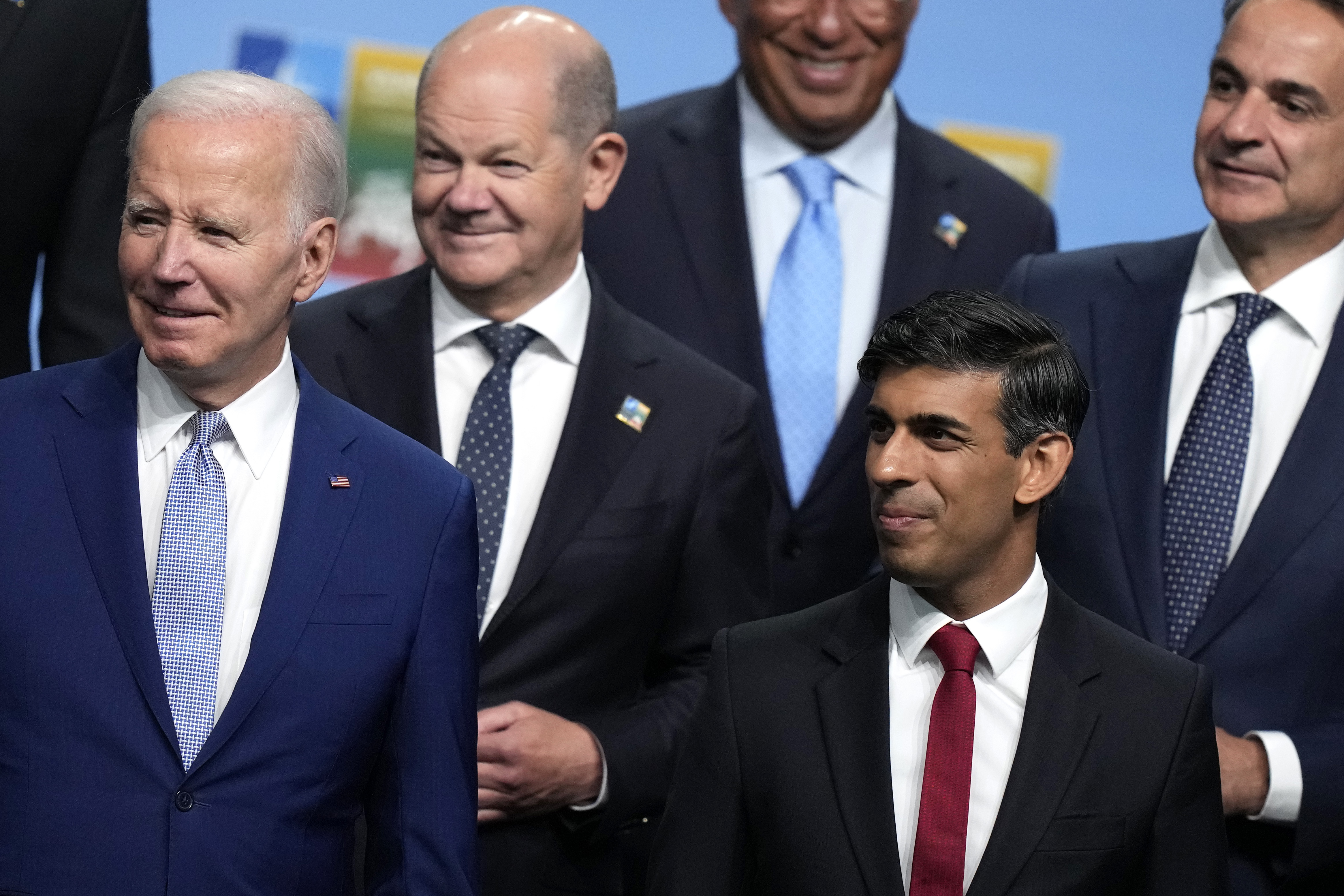 From left, United States President Joe Biden, Germany's Chancellor Olaf Scholz, Portugal's Prime Minister Antonio Costa, British Prime Minister Rishi Sunak and Greece's Prime Minister Kyriakos Mitsotakis during a group photo at a NATO summit in Vilnius, Lithuania, Tuesday, July 11, 2023. NATO's summit began Tuesday with fresh momentum after Turkey withdrew its objections to Sweden joining the alliance, a step toward the unity that Western leaders have been eager to demonstrate in the face of Russia's invasion of Ukraine. (AP Photo/Pavel Golovkin)
From left, United States President Joe Biden, Germany's Chancellor Olaf Scholz, Portugal's Prime Minister Antonio Costa, British Prime Minister Rishi Sunak and Greece's Prime Minister Kyriakos Mitsotakis during a group photo at a NATO summit in Vilnius, Lithuania, Tuesday, July 11, 2023. NATO's summit began Tuesday with fresh momentum after Turkey withdrew its objections to Sweden joining the alliance, a step toward the unity that Western leaders have been eager to demonstrate in the face of Russia's invasion of Ukraine. (AP Photo/Pavel Golovkin)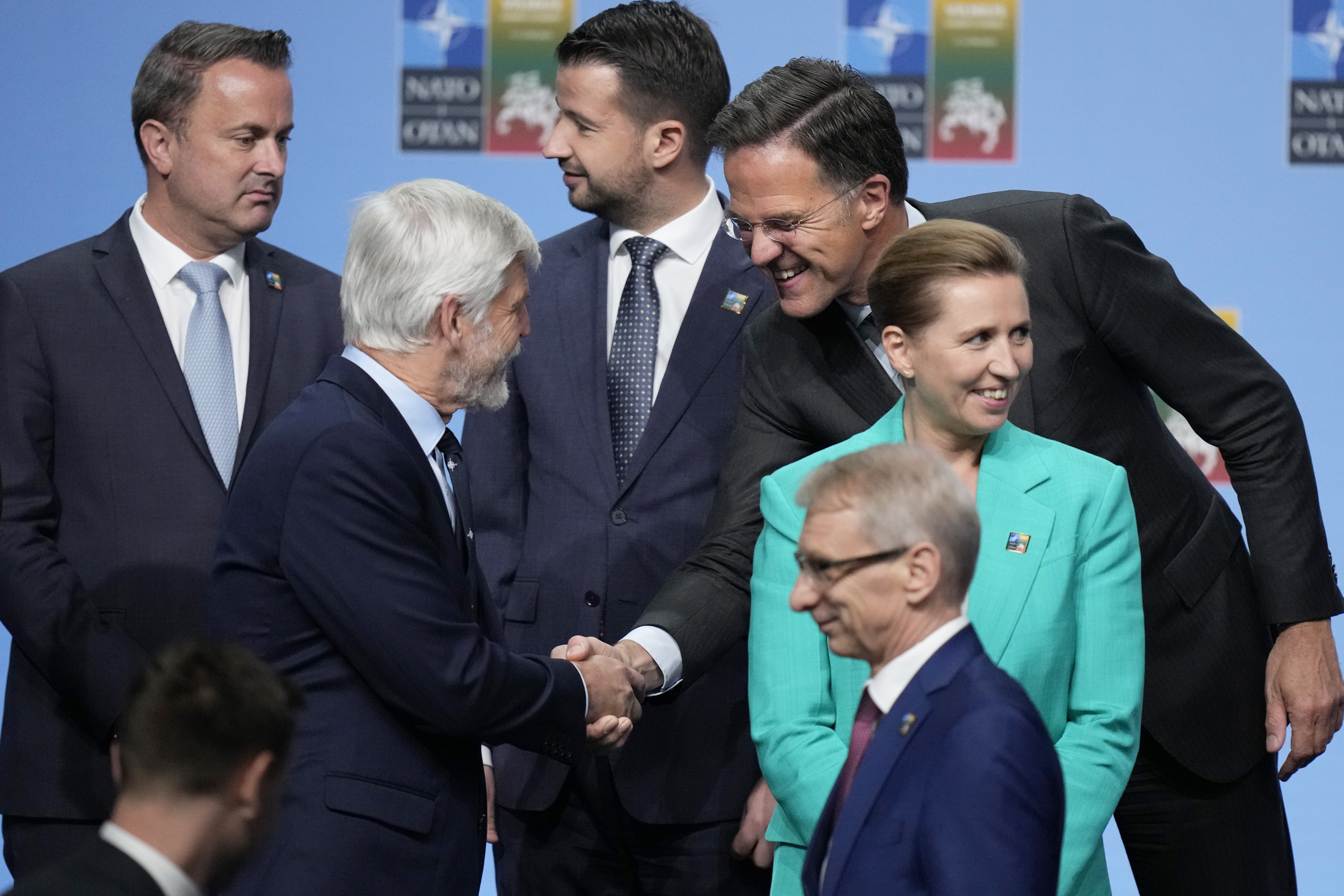 Netherland's Prime Minister Mark Rutte, right, shakes hands with Czech Rebublic's President Petr Pavel, second left, during a group photo at a NATO summit in Vilnius, Lithuania, Tuesday, July 11, 2023. NATO's summit began Tuesday with fresh momentum after Turkey withdrew its objections to Sweden joining the alliance, a step toward the unity that Western leaders have been eager to demonstrate in the face of Russia's invasion of Ukraine. (AP Photo/Pavel Golovkin)
Netherland's Prime Minister Mark Rutte, right, shakes hands with Czech Rebublic's President Petr Pavel, second left, during a group photo at a NATO summit in Vilnius, Lithuania, Tuesday, July 11, 2023. NATO's summit began Tuesday with fresh momentum after Turkey withdrew its objections to Sweden joining the alliance, a step toward the unity that Western leaders have been eager to demonstrate in the face of Russia's invasion of Ukraine. (AP Photo/Pavel Golovkin)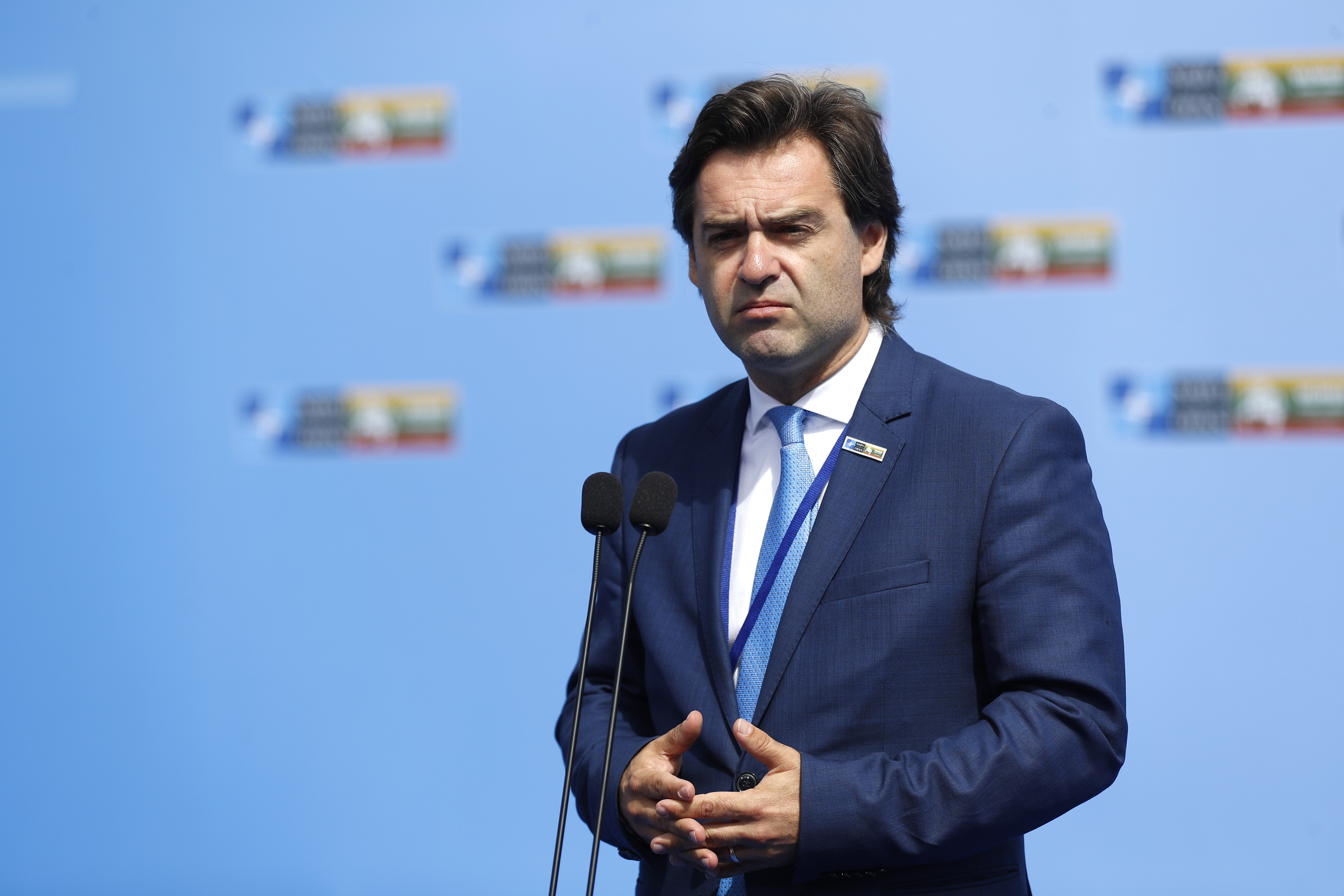 Moldova's Foreign Minister Nicu Popescu speaks with the media during arrivals of NATO Partner Nations during the NATO summit in Vilnius, Lithuania, Tuesday, July 11, 2023. NATO's summit began Tuesday with fresh momentum after Turkey withdrew its objections to Sweden joining the alliance, a step toward the unity that Western leaders have been eager to demonstrate in the face of Russia's invasion of Ukraine. (AP Photo/Mindaugas Kulbis)
Moldova's Foreign Minister Nicu Popescu speaks with the media during arrivals of NATO Partner Nations during the NATO summit in Vilnius, Lithuania, Tuesday, July 11, 2023. NATO's summit began Tuesday with fresh momentum after Turkey withdrew its objections to Sweden joining the alliance, a step toward the unity that Western leaders have been eager to demonstrate in the face of Russia's invasion of Ukraine. (AP Photo/Mindaugas Kulbis)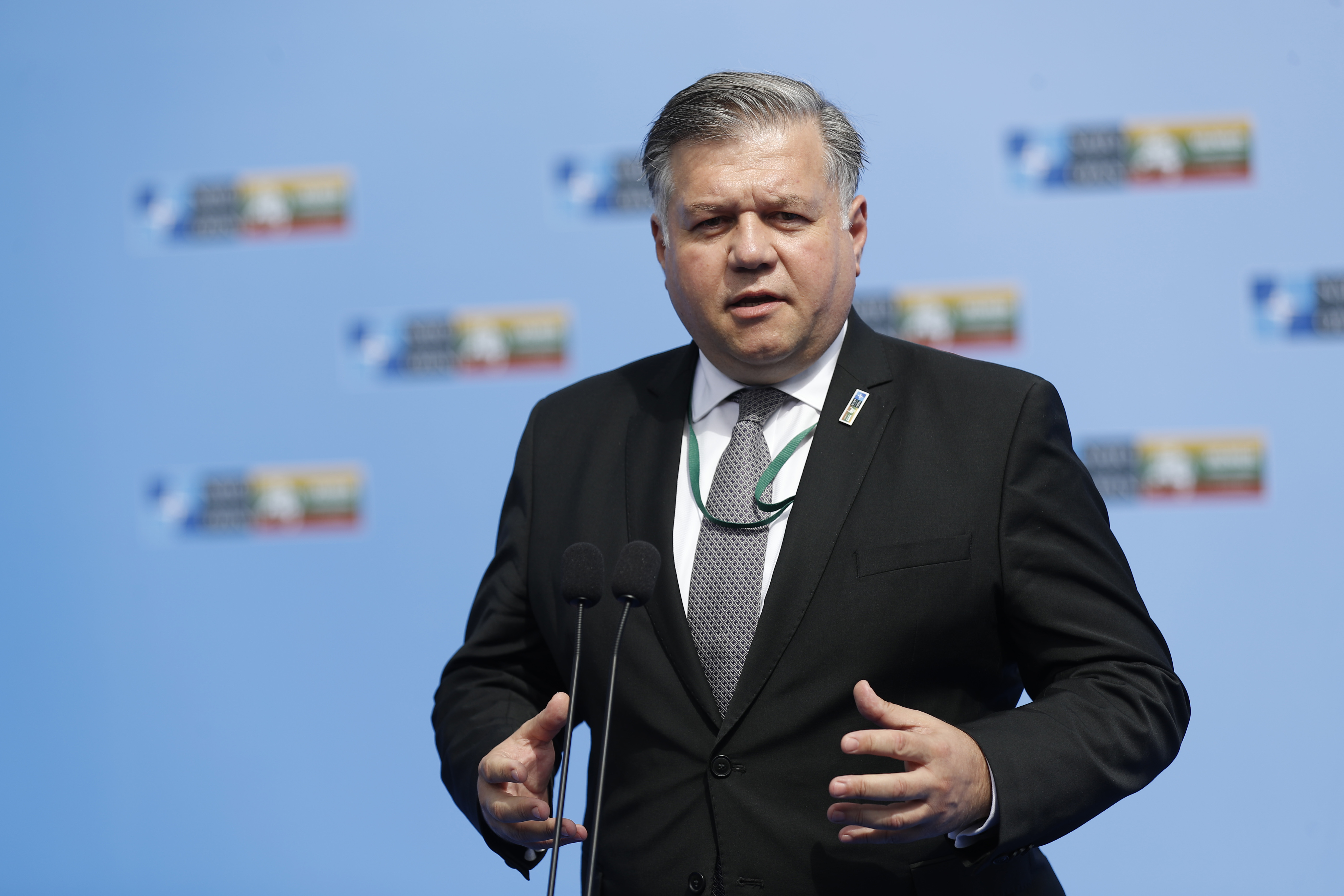 Bosnia and Herzegovina's Deputy Foreign Minister Josip Brkic speaks with the media during arrivals of NATO Partner Nations during the NATO summit in Vilnius, Lithuania, Tuesday, July 11, 2023. NATO's summit began Tuesday with fresh momentum after Turkey withdrew its objections to Sweden joining the alliance, a step toward the unity that Western leaders have been eager to demonstrate in the face of Russia's invasion of Ukraine. (AP Photo/Mindaugas Kulbis)
Bosnia and Herzegovina's Deputy Foreign Minister Josip Brkic speaks with the media during arrivals of NATO Partner Nations during the NATO summit in Vilnius, Lithuania, Tuesday, July 11, 2023. NATO's summit began Tuesday with fresh momentum after Turkey withdrew its objections to Sweden joining the alliance, a step toward the unity that Western leaders have been eager to demonstrate in the face of Russia's invasion of Ukraine. (AP Photo/Mindaugas Kulbis)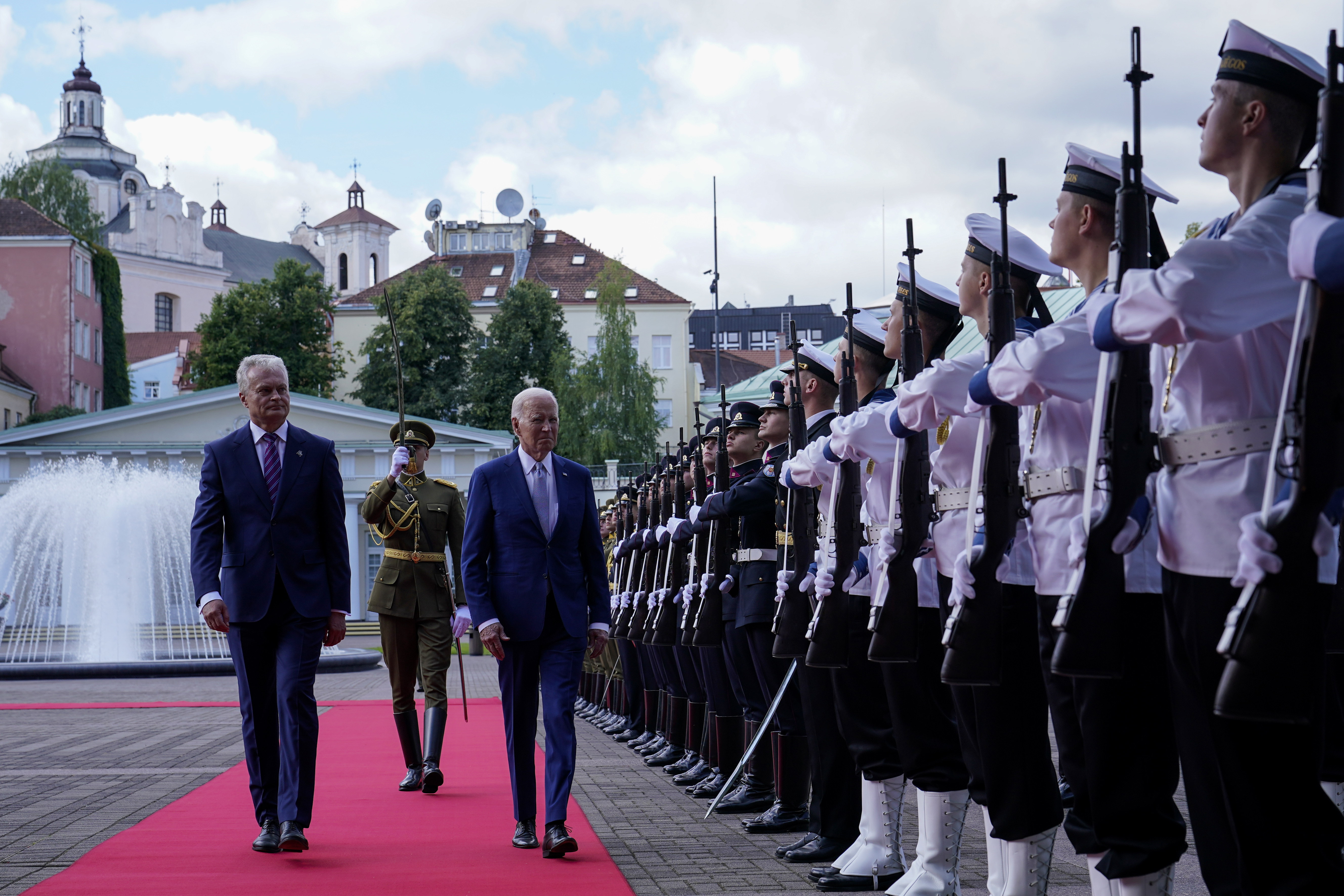 Lithuania's President Gitanas Nauseda, left, welcomes U.S. President Joe Biden at the Presidential Palace prior the NATO summit in Vilnius, Lithuania, Tuesday, July 11, 2023. Russia's war on Ukraine will top the agenda when NATO leaders meet in the Lithuanian capital Vilnius on Tuesday and Wednesday. (AP Photo/Susan Walsh)
Lithuania's President Gitanas Nauseda, left, welcomes U.S. President Joe Biden at the Presidential Palace prior the NATO summit in Vilnius, Lithuania, Tuesday, July 11, 2023. Russia's war on Ukraine will top the agenda when NATO leaders meet in the Lithuanian capital Vilnius on Tuesday and Wednesday. (AP Photo/Susan Walsh)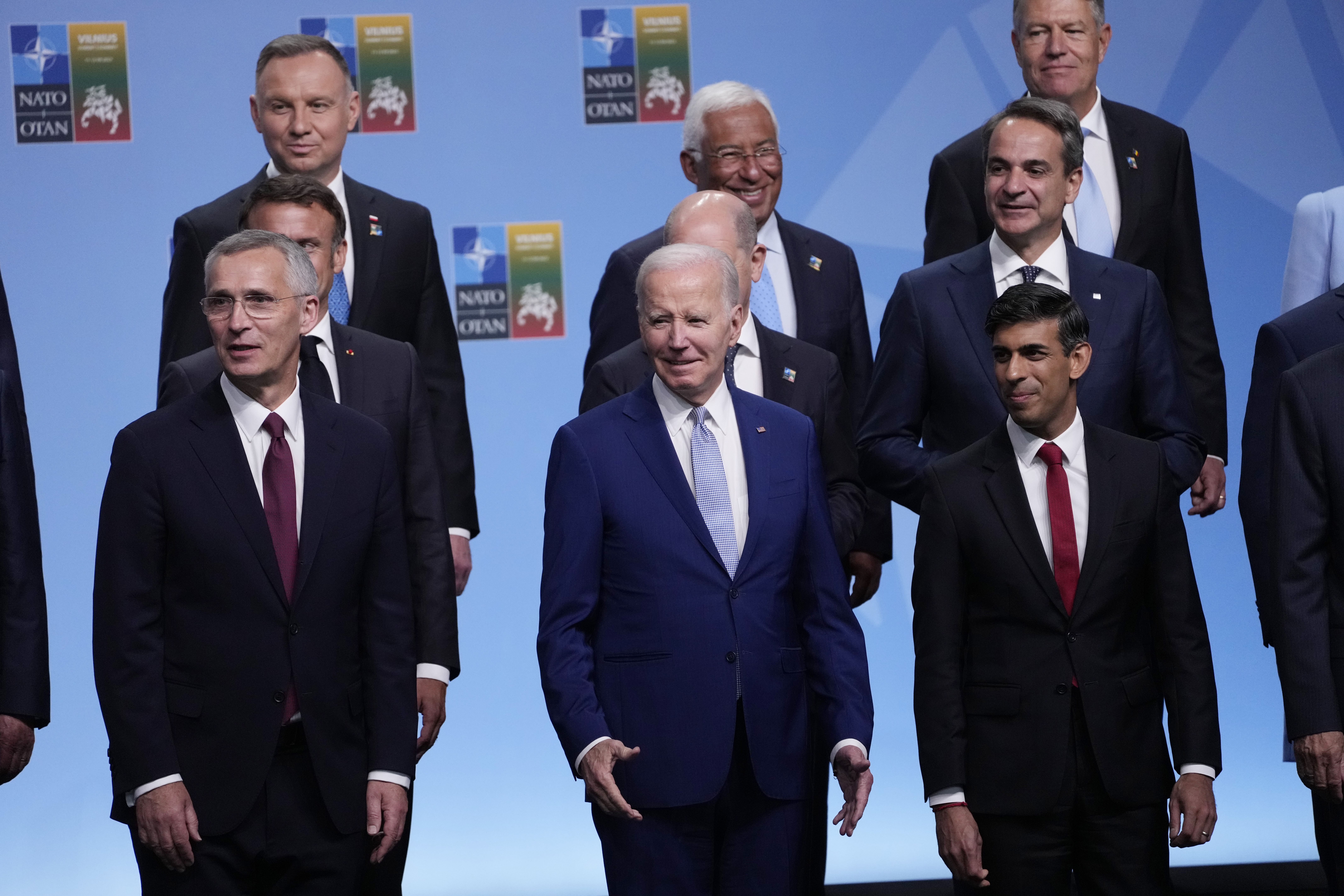 Front row from left, NATO Secretary General Jens Stoltenberg, President Joe Biden, and Britain's Prime Minister Rishi Sunak, second row from left French President Emmanuel Macron, German Chancellor Olaf Scholz, and Greek Prime Minister Kyriakos Mitsotaki, third row from left are, Polish President Andrzej Duda, Portugal's Prime Minister Antonio Costa and Romania's President Klaus Werner Iohannis, reacts at the conclusion of the family photo at the NATO summit in Vilnius, Lithuania, Tuesday, July 11, 2023. (AP Photo/Susan Walsh, Pool)
Front row from left, NATO Secretary General Jens Stoltenberg, President Joe Biden, and Britain's Prime Minister Rishi Sunak, second row from left French President Emmanuel Macron, German Chancellor Olaf Scholz, and Greek Prime Minister Kyriakos Mitsotaki, third row from left are, Polish President Andrzej Duda, Portugal's Prime Minister Antonio Costa and Romania's President Klaus Werner Iohannis, reacts at the conclusion of the family photo at the NATO summit in Vilnius, Lithuania, Tuesday, July 11, 2023. (AP Photo/Susan Walsh, Pool)